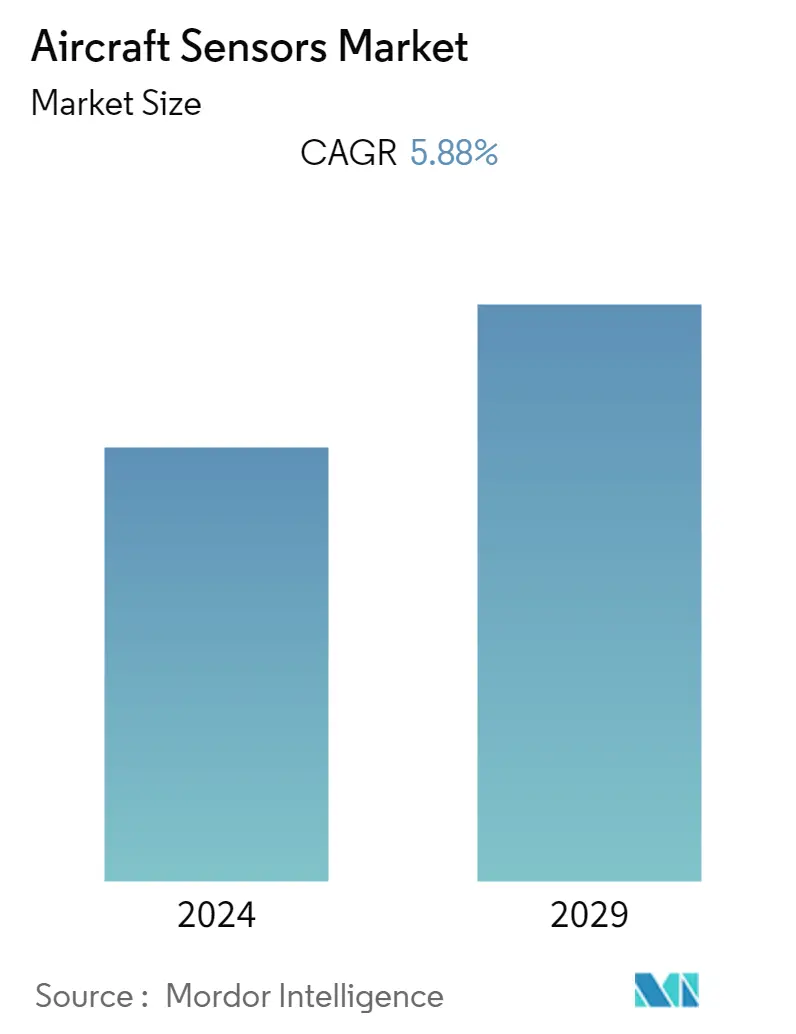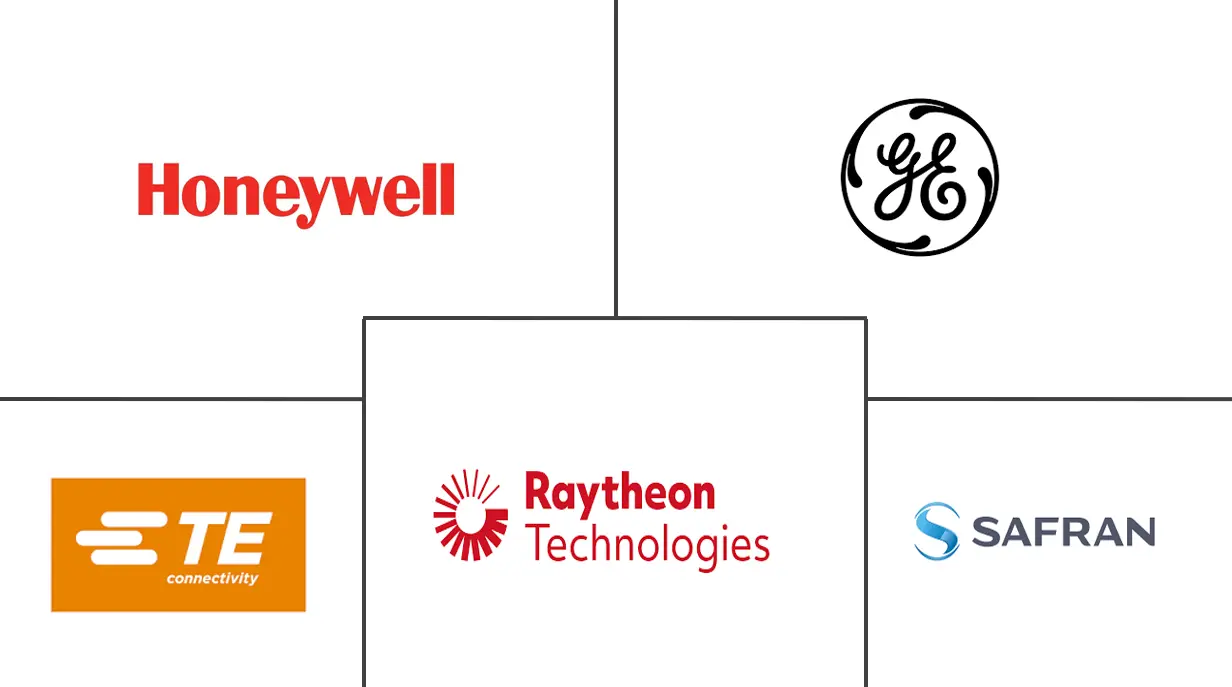Market Size of Aircraft Sensors Industry

| Study Period | 2020 - 2029 |
| Base Year For Estimation | 2023 |
| CAGR | 5.88 % |
| Fastest Growing Market | Asia Pacific |
| Largest Market | North America |
| Market Concentration | High |
Major Players
*Disclaimer: Major Players sorted in no particular order |
Aircraft Sensors Market Analysis
The aircraft sensors market is projected to register a CAGR of 5.88% during the forecast period.
- The COVID-19 pandemic severely impacted the global aviation market; flight activity was muted for more than a quarter, and multiple aircraft orders were delayed, which led to a brutal disruption of the demand trajectory of aircraft sensors. Further, 2021 was marked as the year of transition; air passenger numbers are expected to be equivalent to or even surpass the pre-COVID levels by 2023, which is expected to drive the demand for aircraft sensors over the coming years.
- The innovation in safety and effective handling of aircraft would drive the aircraft sensor market. A modern aircraft integrates fly-by-computer systems, where signals from sensors monitor the various activities going on in the flight, such as thrust levels, pedals, and flight sticks. The information is then received by flight management systems that control surfaces like ailerons and flaps.
- Moreover, the increasing integration of the Internet of Things (IoT) in airplanes to gain real-time statistics is raising the utilization and need for sensors to generate more accurate data, which is expected to drive the aircraft sensor market. However, the major factor impeding the growth of the market is the high R&D, manufacturing, and maintenance costs of sophisticated sensors, which raise questions on the economic viability of emerging technologies to be integrated onboard next-generation aircraft.
Aircraft Sensors Industry Segmentation
Aircraft sensors are critical to providing accurate data for safe and effective flight times, as well as the take-off and landing of the aircraft, as they provide feedback on a wide array of aircraft operational parameters such as the temperature and pressure of the cabin, controlling the wings and flaps, and others.
The market is segmented by sensor type, aircraft type, and geography. By aircraft type, the market is segmented into commercial and business aircraft and military aircraft. By sensor type, the market is segmented into temperature, pressure, position, flow, torque, radar, accelerometer, proximity, and other sensor types. By geography, the market is segmented into North America, Europe, Asia-Pacific, Latin America, and Middle East and Africa.
The report offers market value and forecasts in terms of USD billion.
| By Aircraft Type | |
| Commercial Aircraft | |
| Military Aircraft | |
| General Aviation Aircraft |
| By Sensor Type | |
| Temperature | |
| Pressure | |
| Position | |
| Flow | |
| Torque | |
| Radar | |
| Accelerometers | |
| Proximity | |
| Other Sensor Types |
| Geography | |||||||
| |||||||
| |||||||
| |||||||
| |||||||
|
Aircraft Sensors Market Size Summary
The aircraft sensors market is poised for significant growth, driven by the resurgence of the aviation industry post-COVID-19 and the increasing integration of advanced technologies in modern aircraft. As air travel demand rebounds to pre-pandemic levels, the need for sophisticated sensors to enhance safety and operational efficiency is expected to rise. The integration of IoT technologies in aircraft is further propelling the demand for sensors, as they provide real-time data crucial for flight management systems. However, the high costs associated with research, development, manufacturing, and maintenance of these sensors pose challenges to market expansion. Despite these hurdles, the market is witnessing a steady growth trajectory, supported by innovations in sensor technology and their critical role in aircraft operations.
In North America, particularly the United States, the demand for new aircraft across various sectors is driving the growth of the aircraft sensors market. The region's aerospace industry is highly competitive, with significant contributions to the economy through export sales and foreign direct investment. Major players in the market, such as Honeywell International Inc., Raytheon Technologies Corporation, and Safran SA, are actively involved in numerous aircraft programs, catering to the needs of original equipment manufacturers and maintenance, repair, and overhaul sectors. The market's consolidation is evident, with high entry barriers due to substantial R&D costs and stringent regulatory requirements. Recent advancements, such as Northrop Grumman's EMRIS and Airbus's integration of next-generation sensors, highlight the ongoing innovation and strategic developments within the industry, further bolstering the market's growth prospects.
Aircraft Sensors Market Size - Table of Contents
-
1. MARKET DYNAMICS
-
1.1 Market Overview
-
1.2 Market Drivers
-
1.3 Market Restraints
-
1.4 Industry Attractiveness - Porter's Five Forces Analysis
-
1.4.1 Threat of New Entrants
-
1.4.2 Bargaining Power of Buyers/Consumers
-
1.4.3 Bargaining Power of Suppliers
-
1.4.4 Threat of Substitute Products
-
1.4.5 Intensity of Competitive Rivalry
-
-
-
2. MARKET SEGMENTATION
-
2.1 By Aircraft Type
-
2.1.1 Commercial Aircraft
-
2.1.2 Military Aircraft
-
2.1.3 General Aviation Aircraft
-
-
2.2 By Sensor Type
-
2.2.1 Temperature
-
2.2.2 Pressure
-
2.2.3 Position
-
2.2.4 Flow
-
2.2.5 Torque
-
2.2.6 Radar
-
2.2.7 Accelerometers
-
2.2.8 Proximity
-
2.2.9 Other Sensor Types
-
-
2.3 Geography
-
2.3.1 North America
-
2.3.1.1 United States
-
2.3.1.2 Canada
-
-
2.3.2 Europe
-
2.3.2.1 United Kingdom
-
2.3.2.2 France
-
2.3.2.3 Germany
-
2.3.2.4 Italy
-
2.3.2.5 Rest of Europe
-
-
2.3.3 Asia-Pacific
-
2.3.3.1 China
-
2.3.3.2 Japan
-
2.3.3.3 India
-
2.3.3.4 Rest of Asia-Pacific
-
-
2.3.4 Latin America
-
2.3.4.1 Brazil
-
2.3.4.2 Mexico
-
2.3.4.3 Rest of Latin America
-
-
2.3.5 Middle East and Africa
-
2.3.5.1 United Arab Emirates
-
2.3.5.2 Saudi Arabia
-
2.3.5.3 South Africa
-
2.3.5.4 Rest of Middle East and Africa
-
-
-
Aircraft Sensors Market Size FAQs
What is the current Aircraft Sensors Market size?
The Aircraft Sensors Market is projected to register a CAGR of 5.88% during the forecast period (2024-2029)
Who are the key players in Aircraft Sensors Market?
Honeywell International Inc., Raytheon Technologies Corporation, The General Electric Company, Curtiss-Wright Corporation and Safran SA are the major companies operating in the Aircraft Sensors Market.

